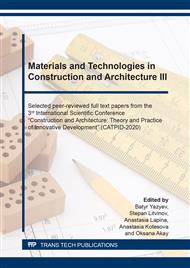[1]
L.B. Svatovskaya, M.M. Sychev, Activated hardening of cements, Stroyizdat, Leningrad, (1983).
Google Scholar
[2]
G.R. Wagner, Physical chemistry of activation processes of cement dispersions, Naukova Dumka, Kiev, (1980).
Google Scholar
[3]
V.I. Klassen, Magnetization of water systems, 2nd ed., Revised. and add., Chemistry, Moscow, (1982).
Google Scholar
[4]
N.N. Kruglitsky, Physical and chemical mechanics of dispersed structures in magnetic, Science thought, Kiev, (1976).
Google Scholar
[5]
V.I. Kalashnikov, V.T. Erofeev, O.V. Tarakanov, Suspension-filled concrete mixes for powder-activated concrete of a new generation, News of higher educational institutions, Construction. 4 (2016) 30-37.
Google Scholar
[6]
V.I. Kalashnikov, V.T. Erofeev, O.V. Tarakanov, Feasibility study for the implementation of architectural and decorative powder-activated carbonate sand concrete, News of higher educational institutions. Construction. 6 (690) (2016) 39-46.
Google Scholar
[7]
Yu.M. Bazhenov, S.V. Fedosov, V.T. Erofeev, A.A. Matvievsky, E.A. Mitina, D.V. Emelyanov, P.V. Yudin, Cement composites based on magnetically and electrochemically activated mixing water, Saransk, (2011).
Google Scholar
[8]
V.T. Erofeev, A.P. Fedortsov, V.A. Fedortsov, Improving the corrosion resistance of cement composites with active additives, Construction and reconstruction. 2 (88) (2020) 51-60.
Google Scholar
[9]
S.V. Fedosov, V.E. Rumyantseva, S.A. Loginova, To the issues of cement stone biocorrosion. In the collection: Basic, exploratory and applied research of the Russian Academy of Architecture and Construction Sciences on the scientific support for the development of architecture, urban planning and the construction industry of the Russian Federation in 2018, the Russian Academy of Architecture and Construction Sciences. Moscow (2019) 573-579.
DOI: 10.31659/0044-4472-2020-7-34-40
Google Scholar
[10]
J. Dick, W. De Windt, B. De Graef, Bio-deposition of a calcium carbonate layer on degraded limestone by Bacillus species. 17 (4) (2006) 357–367.
DOI: 10.1007/s10532-005-9006-x
Google Scholar
[11]
A.A. Patil, Effect of curing condition on strength of geopolymer concrete, Advances in Concrete Construction. 2 (1) (2014) 29–37.
DOI: 10.12989/acc.2014.2.1.029
Google Scholar
[12]
V.T. Erofeev, Al Dulaimi S.D.S., V.F. Smirnov, V.T. Fomichev, Bacteria for bio-concrete. BST: Bulletin of construction equipment. 8 (1008) (2018) 26-29.
Google Scholar
[13]
D.I. Boyarkin, V.T. Fomichev, V.T. Erofeev, D.V. Emelyanov, A.A. Matvievsky, Modeling the processes of activation of natural mixing water of concrete in an electromagnetic field, Basic research. 2-6 (2015) 1157-1165.
Google Scholar
[14]
Yu.M. Bazhenov, V.T. Fomichev, V.T. Erofeev, S.V. Fedosov, A.A. Matvievsky, A.K. Osipov, D.V. Emelyanov, E.A. Mitina, P.A.T. Yudin, The theoretical justification for obtaining concrete based on electrochemically and electromagnetically activated mixing water, Internet Herald Volgograd State Technical University (IACE of VSTU). 2 (22) (2012) 4.
Google Scholar
[15]
V. Erofeev, D. Emelyanov, I. Tretiakov, V. Kalashnikov, E. Balathanova, I. Erofeeva, V. Smirnov, A. Matvievskiy, Biological resistance of cement composites filled with dolomite powders, Solid State Phenomena. 871 (2016) 33-39.
DOI: 10.4028/www.scientific.net/msf.871.33
Google Scholar


